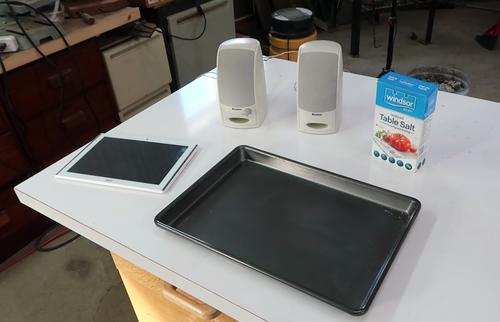 I had seen a few experiments showing resonance on a metal plate, there are
lots
of examples on YouTube. It's also called a "Chladni plate".
I had seen a few experiments showing resonance on a metal plate, there are
lots
of examples on YouTube. It's also called a "Chladni plate".
 I had seen a few experiments showing resonance on a metal plate, there are
lots
of examples on YouTube. It's also called a "Chladni plate".
I had seen a few experiments showing resonance on a metal plate, there are
lots
of examples on YouTube. It's also called a "Chladni plate".
I had the idea of trying to reproduce such an experiment using really basic means.
So instead of fancy equipment, I'm using a tablet computer, some computer speakers, a cookie sheet, and some salt.
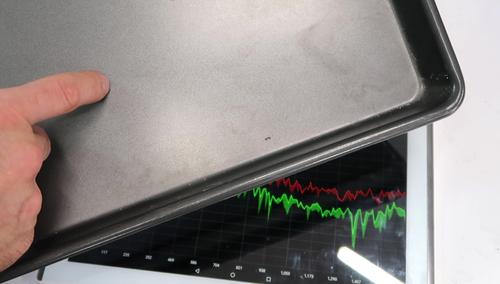 The first thing to figure out is what frequencies the cookie sheet will resonate
at. I installed the "Spectrum Analyze" app on my Android tablet.
I tapped the cookie sheet and watched the spectrum display to see which frequencies
the cookie sheet liked to resonate at.
The first thing to figure out is what frequencies the cookie sheet will resonate
at. I installed the "Spectrum Analyze" app on my Android tablet.
I tapped the cookie sheet and watched the spectrum display to see which frequencies
the cookie sheet liked to resonate at.
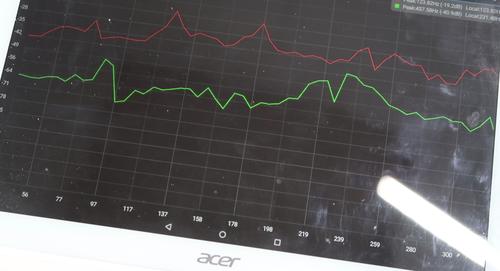
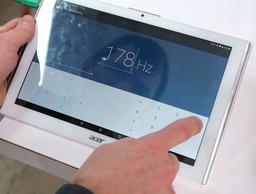 Zooming in, and moving the graph around, I could see a particularly strong one was
at 178 Hz.
Zooming in, and moving the graph around, I could see a particularly strong one was
at 178 Hz.
Next I used an app called "Frequency generator" on the tablet to make that frequency of sound.
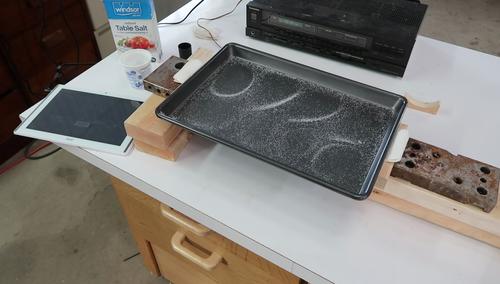 I supported the cookie sheet above a computer speaker. The speaker is facing up
and I turned it up loud while the 178 Hz tone was playing. Spreading some
salt on the cookie sheet revealed the modes of vibration.
I supported the cookie sheet above a computer speaker. The speaker is facing up
and I turned it up loud while the 178 Hz tone was playing. Spreading some
salt on the cookie sheet revealed the modes of vibration.
The cookie sheet has a standing wave pattern on it, where some parts deflect upward while other parts deflect down. The areas in between move very little.
The salt in areas of strong vibration tends to bounce away from those areas and settle where vibrations are weaker. So the lines formed by the salt show the "nodes" of the vibration — areas between the stronger vibrations.
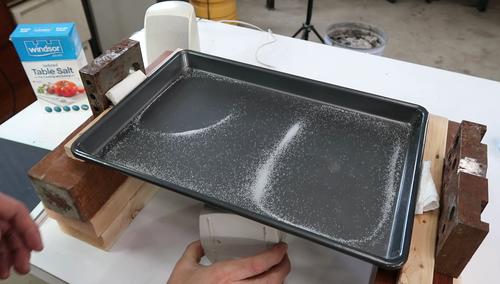 Trying a lower frequency. The area of the cookie sheet is divided into three,
left top corner, middle and right 40%. Basically, the left top corner
and the right side move up at the same time that the remaining area (middle to
bottom left corner) moves down, and vice versa, and the salt settles in between.
Trying a lower frequency. The area of the cookie sheet is divided into three,
left top corner, middle and right 40%. Basically, the left top corner
and the right side move up at the same time that the remaining area (middle to
bottom left corner) moves down, and vice versa, and the salt settles in between.
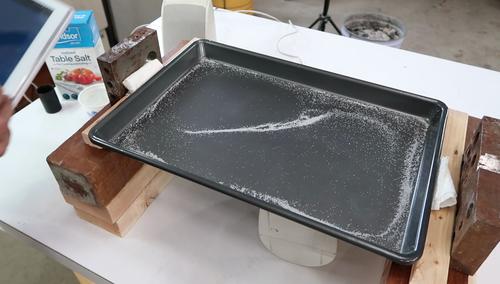 An even lower frequency, this time the cookie sheet is just two zones.
An even lower frequency, this time the cookie sheet is just two zones.
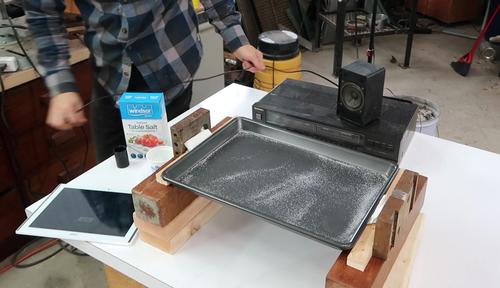 I tried higher frequencies, but the computer speakers were not powerful enough
to get the salt to move much. So I switched to using my stereo amplifier
and a small stereo speaker.
I tried higher frequencies, but the computer speakers were not powerful enough
to get the salt to move much. So I switched to using my stereo amplifier
and a small stereo speaker.
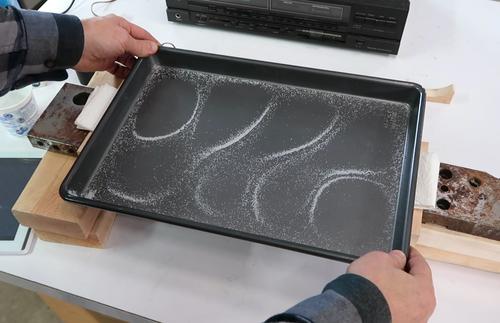 This worked better. Higher frequencies produce more intricate patterns.
This worked better. Higher frequencies produce more intricate patterns.
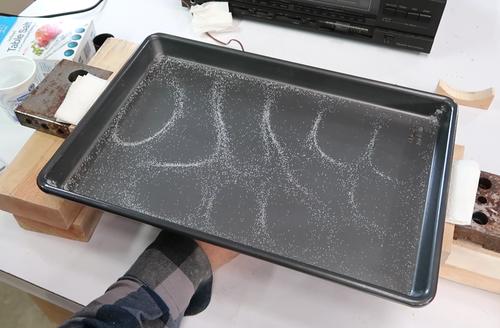 And another. But this is as high a frequency as I was able to go.
And another. But this is as high a frequency as I was able to go.
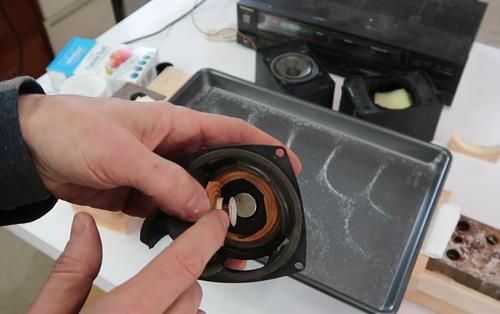 I had turned up the power more at about 700 Hz. I couldn't see any deflection
in the speaker, but at some point the sound changed and something smelled burnt.
I had turned up the power more at about 700 Hz. I couldn't see any deflection
in the speaker, but at some point the sound changed and something smelled burnt.
When I turned the sound off, and pushed the middle of the speaker, I could hear the speaker's voice coil scratching against the magnet. The speaker was shot.
So I tore it open to see the damage. The voice coil was blackened (it's normally red magnet wire). The heat had caused it to distort, and then it rubbed against the magnet.
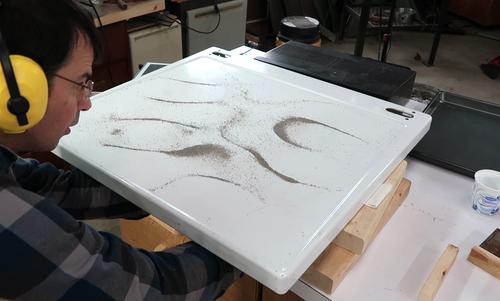 So I didn't want to go to higher frequencies, but I figured I could get more patterns
by using a larger sheet of metal. This one is the top part of an old clothes dryer.
So I didn't want to go to higher frequencies, but I figured I could get more patterns
by using a larger sheet of metal. This one is the top part of an old clothes dryer.
I also switched from salt to sand so it would show up better against the white surface.
It's really cool how, after dialling in a frequency, the pattern slowly emerges in the sand.
I wasn't able to get results as clean or spectacular as other experiments on YouTube, but the cool thing is, I was able to do these experiments without using any scientific equipment - using just regular household items!
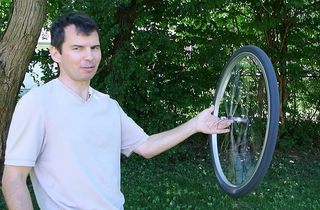 Gyro effect explained
Gyro effect explained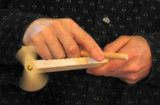 The hui game. Also
The hui game. Also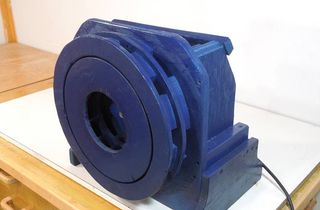 Building an air raid siren
Building an air raid siren